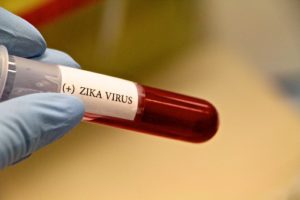Emerging infections, such as the Zika virus (ZIKV), continue to surface due to global travel, migration, and the spread of vectors including mosquitoes. The first ZIKV outbreak occurred in 2007 in the Pacific and has quickly spread to most of the Americas. Blood donations have tested positive from asymptomatic donors (up to 3% during the 2013-14 French Polynesia outbreak) and cases of probable transfusion-transmission have been observed in Brazil. ZIKV positive donations have now been confirmed in the continental United States. In 2016, the U.S. Food and Drug Administration (FDA) recommended that blood donations be screened with a nucleic acid test (NAT) or components treated with pathogen inactivation technology. Researchers investigated the use of pathogen inactivation for RBCs by spiking units with ZIKV grown in culture. Viral titers and RNA loads were calculated both before and after chemical pathogen inactivation using amustaline (S-303) and glutathione (GSH). Pathogen inactivation was found to completely inactivate more than 5.99 log TCID50/mL in RBCs spiked with ZIKV at levels higher than what is found in asymptomatic donors. Pathogen inactivation holds promise for abating ZIKV contamination and other emerging infections in the blood supply.
References:
- Galel SA, Williamson PC, Busch MP, Stanek D, Bakkour S, Stone M, Lu K, Jones S, Rossmann SN, Pate LL, cobas Zika INDSG. First Zika-positive donations in the continental United States. Transfusion 2017.
- Laughhunn A, Santa Maria F, Broult J, Lanteri MC, Stassinopoulos A, Musso D, Aubry M. Amustaline (S-303) treatment inactivates high levels of Zika virus in red blood cell components. Transfusion 2017.

